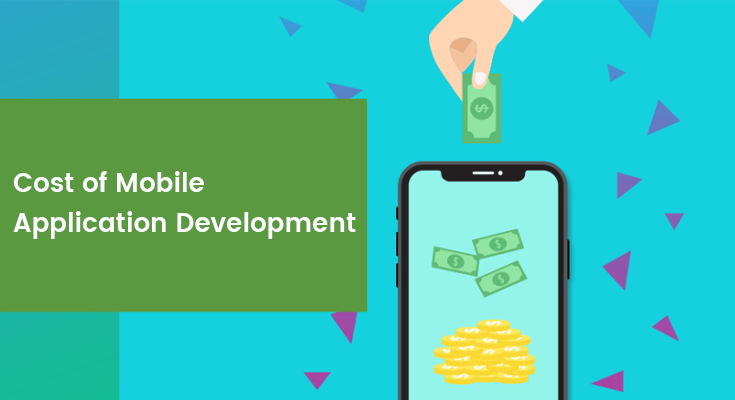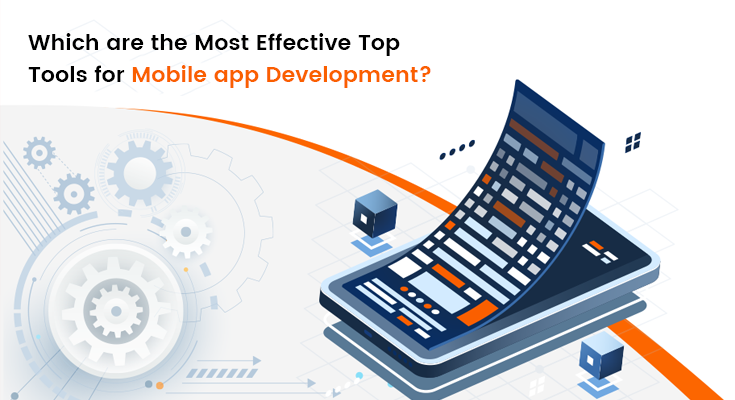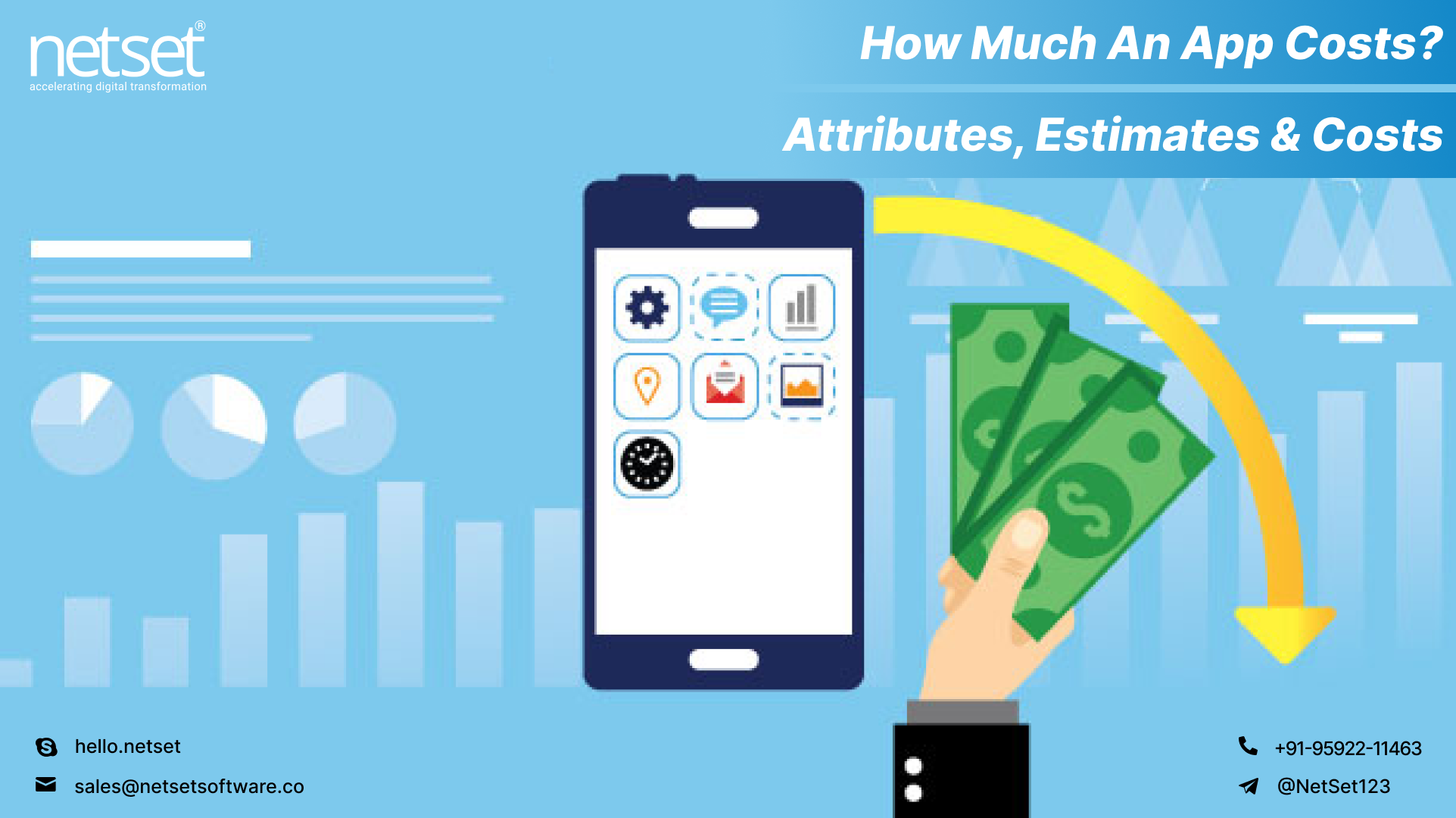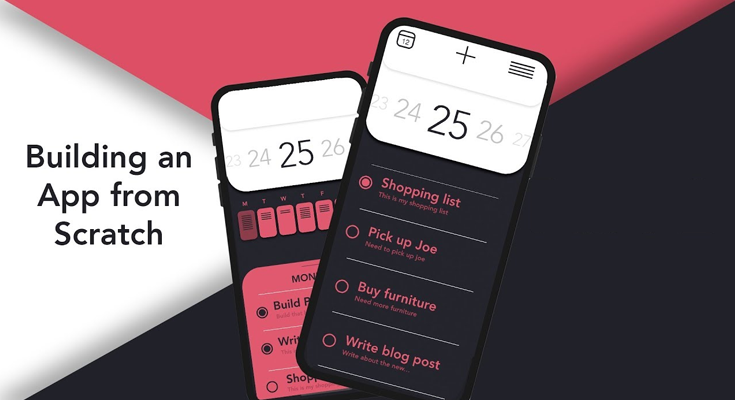The Complete Guide to Developing a Mental Health App with Features like Headspace
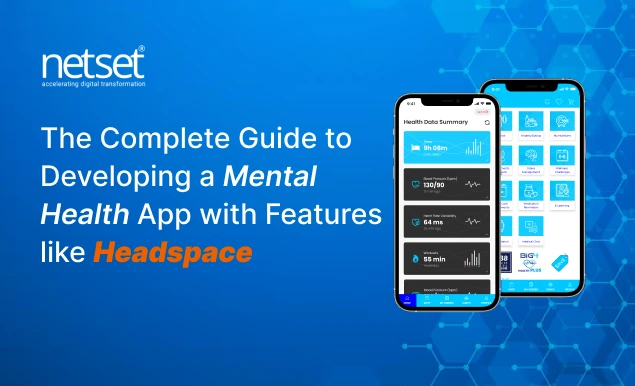
Mental health apps have transformed a lot in the last decade. But do you know that approximately 450 million people of the world’s population are affected by mental disorders?
And most of them have extremely poor access to sufficient mental health support. That is where mental health applications step in to make this support accessible, affordable, and interactive, enabling users to take better care of their mental health on their own terms.
Apps like Headspace have pioneered this movement by making guided meditation, stress management tools, and personalized insights widely available. The guide will walk you through the development of your mental health including user needs insights, design tips, and monetization strategies order.
Now, let’s dive deep into the elaborate process of creating an effective mental health app.
Understanding the Core of a Mental Health App
Mental health apps can help deal with stress, anxiety, and emotional wellness on demand.
Such applications let users improve their well-being at their convenience by providing easy access to guided meditation, journaling, and mood-tracking tools.
What is a Mental Health App?
A mental health app is like a virtual buddy that empowers users to deal with stress, trace emotions, meditate, and practice mindfulness.
Applications make access to tools that will be useful easily available and offer valued support through various features including:
- Guided Meditation: Sessions designed to help users unwind and focus.
- Mood Tracking: Tools that enable tracking of emotions, and through them, finding patterns over time.
- Sleep Aids: Sleep-conducive soundscapes and techniques.
- Journaling Features: Area for thoughts and feelings.
Mental health applications are designed based on personalization and engagement to help build daily routines that contribute to wellness. Many include:
- Progress Tracking: The process of exhibiting an individual’s journey over time helps them in motivation.
- Reminders: Timely notifications to help users practice mindfulness regularly.
- Visual Aids: Compelling graphics prompt and guide the user toward their goals.
Why Are Apps Like Headspace So Successful?
Headspace excels by combining user-centered design with science-backed mindfulness techniques. The clean, intuitive design walks users through guided exercises and makes wellness seem accessible. Features like progress monitoring, push notifications, and suggestions of personalized tracks round off the offerings nicely, with a guarantee that the commitment to mental health will indeed be for the long haul.
With continuous content updates and the integration of user feedback, Headspace keeps the experience continually fresh and current. This level of commitment to user satisfaction goes a long way toward the success and popularity of the product in the competitive mental health app market.
An effective mental health application enables not only the well-being of SMBs but also the supportive community their users are looking for to feel better about their mental health.
Pro Tip: Don’t overwhelm your user with options all on one screen when adding in features. Less is more when it comes to mental health apps; clutter only leads to the drop-off of a user.
User Demographics and Needs
Understanding the accurate knowledge of the demographics of users of mental health apps is important for developing appropriate interventions to meet demand. The end-users are highly confused, including different age groups, backgrounds, and mental health challenges.
- Young Adults (18-24 years old): Most of them want to get rid of, or at least to find ways to reduce stress or anxieties-structure connected with studying in schools and colleges, or with working. They do like apps that would offer them some kind of activity: gamification, social features, and the like.
- Parents and Caregivers: The busy parent often feels increased stress and mental fatigue. They need quick, accessible ways to relax and be mindful that can be fitted into their schedules.
- Working Professionals: Many professionals go into stress and breakdown caused by issues relating to work. They require guided meditation, tracking of mood changes, and quick exercises that can fit into their busy work schedules.
- Seniors 65+: “Older adults may seek cognitive health and relaxation techniques. Designs should be simple in nature, which would certainly include usability for those not tech-savvy.”.
- Individuals with mental health disorders: In cases of depression, anxiety, or PTSD, special resources providing them with coping mechanisms are needed, along with further professional help.
By pinpointing these demographics and understanding their needs, developers can build support into mental health apps that are better targeted, thereby raising overall levels of engagement and effectiveness.
Essential Features to Include in a Mental Health App
In this case, to build a more significant purpose-based mental wellness mobile application, it will generally be centered around guided meditation libraries, mood tracking, and personalized insights.
The mentioned tools allow users to have flexible and customized support, which would bring more value to their journey of well-being.
Key Functionalities Every Mental Health App Needs
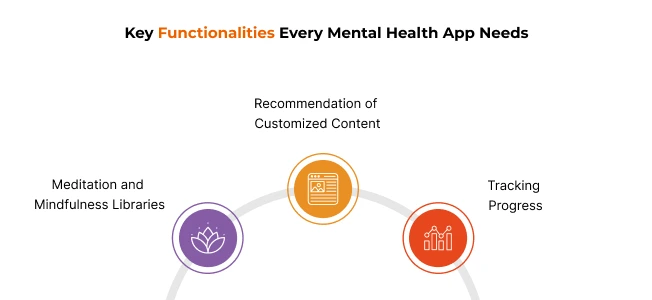
The very best mental health apps are simply the perfect combination of usefulness and simplicity. Here are a few of the basic features that make all of these stand apart:
- Meditation and Mindfulness Libraries: A comprehensive collection of meditations, exercises, and mindfulness sessions offer variety for users. Sessions with different lengths are ideal to be on offer since daily, users may have different availability.
- Recommendation of Customized Content: Recommendations of content utilize AI and the user’s past to show him relevant exercises and tips; therefore, users are engaged. Such personalization in experiences makes the app all the more personal and valued.
- Tracking Progress: It is very critical to provide means and tools to users to track their journey about mental health. Some visual badges or charts increase motivation and encourage one to use this app further.
Must-Have Features vs. Optional Add-Ons
Feature Must-Have Optional Guided Meditation Personalized Notifications Mood Tracking Community Forums Sleep Stories Breathwork Exercises Self-Guided Journals
Adding all these features creates a great balance between core functionality and optional add-ons, permitting users to explore without overwhelming themselves.
Step-by-Step Guide to Developing a Mental Health App
1. Start with Research and Strategy
Developing a mental health app all starts with understanding the audience.
Researching the needs of users, and knowing the strengths and weaknesses of the existing applications, the research phase would then enable you to pinpoint the USP that gives your app a competitive edge above the rest.
2. Collaborate with Professionals
Once you have a clear direction, team up with experts in app development. Hiring specialists is crucial:
- Hire Android app developers who can understand the nuances of wellness app functionalities.
- Hire iOS app development experts with experience in the health and wellness industry.
- You can partner with a prominent app development company Melbourne, or you will get to try out mobile application development in India.
NetSet Software is a recognized leader in bespoke mobile app development India, providing reliable, scalable solutions tailored to business needs. With their expertise, you can transform your app concept into a fully functional product.
3. Design a User-Friendly UI/UX
A mental health app is to be designed in a very user-friendly manner.
The design should be kept clean and, at the same time, calming; the layouts must be intuitive, and it should be easy to navigate around. It should not be cluttered so that the user feels relaxed and encouraged to use the app without frustration.
Pro Tip: Try to avoid using too much color in the app and avoid the use of animations. Too much would scare the user away.
4. Data Security: Storage and Privacy
One will have to make people feel that no invasion of privacy is taking place, especially if sensitive information regarding their mental health is involved.
Introducing end-to-end encryption and compliance with data protection standards like GDPR and HIPAA instills confidence and keeps users safe.
5. Incorporate Gamification for Engagement
Gamification can inspire consistency in users.
In some way, the use of daily streaks, rewards, and achievements can make using an app a fun experience that would somehow encourage users to keep coming back for more.
Of course, these elements must be light enough not to make a wellness app an aggressively competitive platform.
6. Adding Technology and Mental Health
Technology also plays a significant role in the betterment and development of newer ways of making support more accessible, hence upgrading the treatment of mental health.
Some of the key elements especially included:
- Teletherapy: It allows the patient to get in touch with a licensed therapist through video calls, chats, or messages, excluding geographical barriers.
- AI-powered insights include using machine learning algorithms to check user data in order for them to provide individual recommendations based on users’ behaviors and emotional patterns.
- Community support: Social functionalities enable individuals to share experiences and resources through forums or groups of peers in combating feelings of isolation.
| Feature | Description |
| 1. Teletherapy | Connect with therapists remotely via various platforms. |
| 2. AI-Driven Insights | Personalized recommendations based on user behavior. |
| 3. Community Support | Access peer groups for sharing experiences and resources. |
By integrating technology into the process, an app can provide immediate, personalized resources to support overall well-being and facilitate long-term engagement.
Monetization Strategies for Mental Health Apps
The right monetization model is the key to sustainability but not at the cost of user experience. The top choice:
- Freemium Model: Basic features are free, while premium content requires a fee. This model gives your application more coverage since the end-users can try some core features of the application before they commit financially.
- Subscription Plans: Offer weekly, monthly, or yearly subscriptions for full app access. Regular billing provides a steady revenue stream and allows users to choose their preferred duration.
- In-App Purchases: Sell specialized meditation packs, expert consultations, or exclusive content as one-time purchases, enabling users to customize their app experience.
- Table: Comparison of Monetization Models
Monetization Model Comparison
| Model | Pros | Cons |
| 1. Freemium | Attracts more users | Limited premium feature sales |
| 2. Subscription | Predictable revenue | Potentially high user churn |
| 3. In-app purchases | Customizable user experience | Dependent on the high user base |
| 4. Sponsorship | Additional revenue from partnerships | May feel intrusive if not managed well |
The proper choice of the model is very important, and mixing all the approaches will give a balanced and profitable application.
Choosing the Right Technology Stack
Your scalability and performance are determined by the technology stack that your application is using.
According to your budget and the audience you are targeting, perhaps just a combination of native and cross-platform technologies will do for a mental health app.
- Native Development: Ensures better performance of the app and the best user experiences on either Android or iOS. Hire Android app developers or hire iOS app development experts to make sure responsiveness and reliability exist in the app.
- Cross-platform solutions: these include tools like React Native and Flutter, which make it possible to develop both Android and iOS at the same time. This saves time and resources while enabling a wider audience.Pro Tip: Choose a cloud-based backend like Firebase or AWS, which offers scalable and secure data storage solutions.
Quality Assurance and Testing
Testing is the most crucial part of any app development.
Beta testing among real users is the testing of feedback concerning the usability, design, and functionality of an application. This helps get rid of the shortfalls of an application before its release to the public.
Go for these:
- Performance Testing: The application should be stable under all conditions like slow internet, high server loads, etc.
- Security Testing: Scanning for vulnerabilities to protect sensitive information about the users.
Marketing Your Mental Health App
Effective marketing means the difference between reaching the users who need your mental health app most.
This includes pre-launch campaigns, content marketing, and ASO targeted at driving high-quality users to your app and ensuring long-term engagement. Here’s how to create a powerful marketing strategy for your app:
Pre-Launch Campaigns
Start building hype way before launch.
Diversify your channels to create buzz, capture users, and motivate early downloads. The whole pre-launch marketing builds towards a successful app launch.
- Social media teasers: Publish sneak peeks, countdowns, or feature highlights that will help users engage more with the service.
- Influencer Partnerships: Partner with mental health advocates or influencers to extend the reach of your app.
- Mailing Lists: Gather subscribers early on, offering them exclusive access or discounts on Launch Day.
Content Marketing
Content marketing builds authority in mental wellness by engaging the audience to actively buy into valuable, rich information content about mental well-being.
- Blog Posts and Articles: Publish content on mental health topics, wellness tips, and the science behind features of your application.
- Videos and webinars: Organize educative content to showcase the features of an app to engage prospective users.
- Social Media Content: Post periodic tips, inspirational messages, or stories from other users so that you may connect with the audience through Instagram, Facebook, and LinkedIn.
App Store Optimization (ASO)
ASO plays an important role in enhancing the visibility of your app at a higher order than searching and acquiring in the app stores.
- Relevant Keywords: Add the keywords of your research into the title, description, and tags of your application. Let them be aligned with the type of searches users might do.
- Eye-catching Icon and Screenshots: Entice users by accurately showing off core features with an engaging icon and screenshots.
- Compelling Description: Write a clear, benefit-focused description that speaks to your app’s unique value.
You can create a buzz for your mental health app and increase its user base efficiently by scheduling pre-launch campaigns, content marketing, and ASO strategically.
Partnering with an App Development Expert
Developing a mental health app requires not only technical expertise but also deep insight regarding users’ needs.
If you partner with any app development company Melbourne or get experts from Mobile App Development India, then you surely get solutions for your tailored needs at very decent rates.
For bespoke mobile apps development, NetSet Software stands out with a proven track record of delivering high-quality, customized applications. Their team specializes in creating user-friendly, scalable apps that meet diverse client needs.
Future of Mental Health Apps
With the growth in mobile technology, the future of mental health apps is bright, and several trends will shape their development in years to come, including:
- Artificial Intelligence: More powerful AI will, in the future, permit highly individualized support and real-time interventions.
- Virtual reality and augmented reality: These will be presenting therapy in highly immersive modes, such as exercises that induce relaxation or exposure therapy.
- Wearable Technology: Devices will monitor physiological indicators, including heart rate and sleeping patterns, for insight into mental health.
- Cultural Competency and Diversity: Empowerments that focus on providing culturally and linguistically tailored resources to increase relevance and access.
- Integration with Healthcare Systems: The level of integration by startups in technology with traditional options for therapy will be increased to offer comprehensive support to the users.
Coupled with all these trends, mental health applications become part of holistic healthcare, mixing innovation and empathy into valuable support on their mental health journey.
Planning the Next Steps?
Ready to develop your idea into a mental health app? For an app to stand out, the development requires a vision, strategy, and technical know-how.
NetSet Software will guide you through developing your concept into a comprehensive, user-interactive app complete with meditation leading, progress tracking, and personalization. From customized mobile application development to end-to-end support, expert developers at NetSet Software can help your app get noticed and make a difference in the field of mental wellness.
So don’t just take my word, partner with NetSet Software to start your journey from concept to launch. Reach out at NetSet Software for a free consultation, or explore our latest app development insights by visiting NetSet’s blog.


